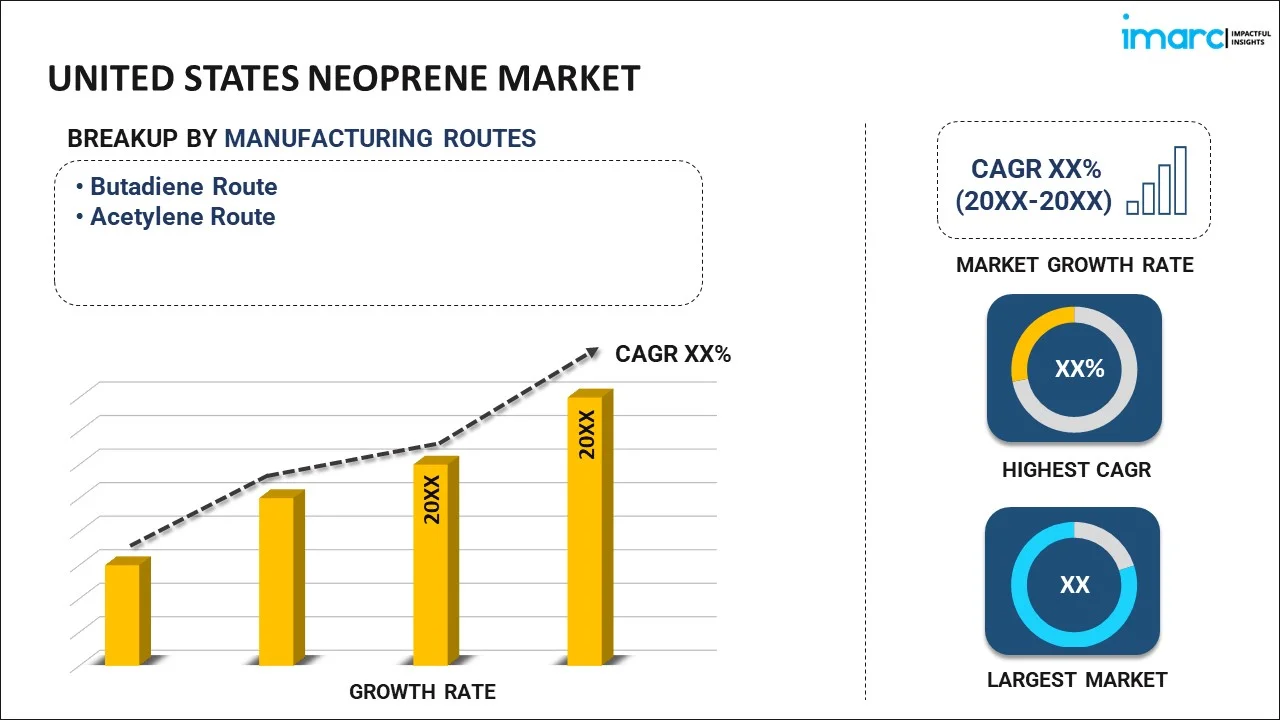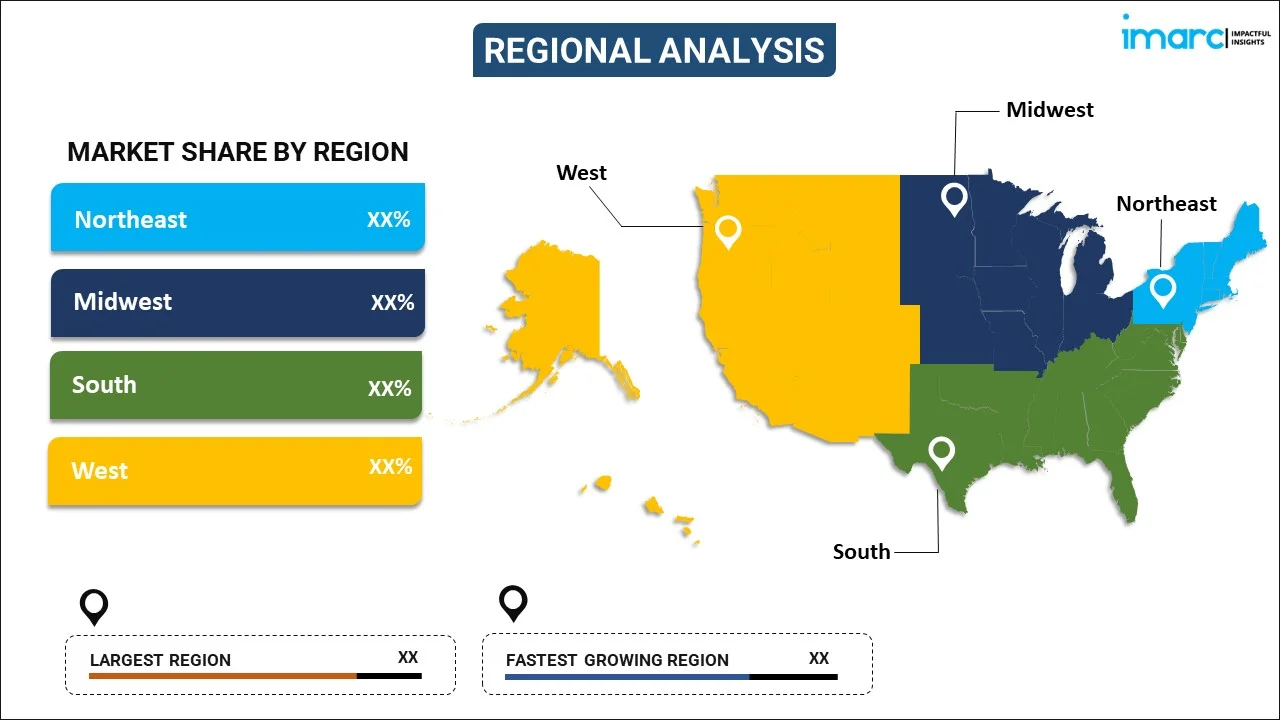
United States Neoprene Market Report by Manufacturing Route (Butadiene Route, Acetylene Route), Grade (General-Purpose Grade Neoprene, Pre-Crosslinked Grade Neoprene, Sulfer-Modified Grade Neoprene, Slow Crystallizing Grade Neoprene), Application (Technical Rubber, Adhesives Industry, Latex Industry), End User (Automotive, Manufacturing, Consumer Goods, Medical), and Region 2025-2033
Market Overview:
The United States neoprene market size reached USD 277.1 Million in 2024. Looking forward, IMARC Group expects the market to reach USD 331.4 Million by 2033, exhibiting a growth rate (CAGR) of 1.91% during 2025-2033.
|
Report Attribute
|
Key Statistics
|
|---|---|
|
Base Year
|
2024
|
|
Forecast Years
|
2025-2033
|
|
Historical Years
|
2019-2024
|
|
Market Size in 2024
|
USD 277.1 Million |
|
Market Forecast in 2033
|
USD 331.4 Million |
| Market Growth Rate (2025-2033) | 1.91% |
Neoprene is a synthetic rubber artificially produced from butadiene through chlorination, isomerization and dehydrochlorination. It is widely used as a substitute for natural latex rubber due to its high-temperature resistance and protection against oxidizing agents. It also offers high tensile strength and ozone resistance. Consequently, it finds extensive applications in various industry verticals, such as automotive, medical, consumer goods and construction.
The increasing population, along with the escalating demand for neoprene from different end use industries to produce customized and efficient products, is strengthening the market growth. For instance, it is widely used in the automotive and construction industries for manufacturing window seals and gaskets, power transmission belts, and shock absorber seals. However, the sudden surge in the coronavirus disease (COVID-19) patients has resulted in lockdowns by the Federal Government of the United States. It has negatively impacted the market growth on account of the temporary closure of various manufacturing units and halt in international trade. The market is anticipated to recover once lockdown relaxations are introduced.
Key Market Segmentation:
IMARC Group provides an analysis of the key trends in each segment of the United States neoprene market report, along with forecasts at the country and regional levels from 2025-2033. Our report has categorized the market based on manufacturing route, grade, application and end user.
Breakup by Manufacturing Route:

- Butadiene Route
- Acetylene Route
Breakup by Grade:
- General-Purpose Grade Neoprene
- Pre-Crosslinked Grade Neoprene
- Sulfer-Modified Grade Neoprene
- Slow Crystallizing Grade Neoprene
Breakup by Application:
- Technical Rubber
- Adhesives Industry
- Latex Industry
Breakup by End User:
- Automotive
- Manufacturing
- Consumer goods
- Medical
Breakup by Region:

- Northeast
- Midwest
- South
- West
Competitive Landscape:
The competitive landscape of the industry has also been examined along with the profiles of the key players.
Report Coverage:
| Report Features | Details |
|---|---|
| Base Year of the Analysis | 2024 |
| Historical Period | 2019-2024 |
| Forecast Period | 2025-2033 |
| Units | Million USD |
| Scope of the Report | Exploration of Historical and Forecast Trends, Industry Catalysts and Challenges, Segment-Wise Historical and Predictive Market Assessment:
|
| Manufacturing Routes Covered | Butadiene Route, Acetylene Route |
| Grades Covered | General-Purpose Grade Neoprene, Pre-Crosslinked Grade Neoprene, Sulfer-Modified Grade Neoprene, Slow Crystallizing Grade Neoprene |
| Applications Covered | Technical Rubber, Adhesives Industry, Latex Industry |
| End Users Covered | Automotive, Manufacturing, Consumer Goods, Medical |
| Regions Covered | Northeast, Midwest, South, West |
| Customization Scope | 10% Free Customization |
| Post-Sale Analyst Support | 10-12 Weeks |
| Delivery Format | PDF and Excel through Email (We can also provide the editable version of the report in PPT/Word format on special request) |
Key Questions Answered in This Report:
- How has the United States neoprene market performed so far and how will it perform in the coming years?
- What has been the impact of COVID-19 on the United States neoprene market?
- What are the key regional markets?
- What is the breakup of the market based on the manufacturing route?
- What is the breakup of the market based on the grade?
- What is the breakup of the market based on the application?
- What is the breakup of the market based on the end user?
- What are the various stages in the value chain of the industry?
- What are the key driving factors and challenges in the industry?
- What is the structure of the United States neoprene market and who are the key players?
- What is the degree of competition in the industry?
Need more help?
- Speak to our experienced analysts for insights on the current market scenarios.
- Include additional segments and countries to customize the report as per your requirement.
- Gain an unparalleled competitive advantage in your domain by understanding how to utilize the report and positively impacting your operations and revenue.
- For further assistance, please connect with our analysts.
 Request Customization
Request Customization
 Speak to an Analyst
Speak to an Analyst
 Request Brochure
Request Brochure
 Inquire Before Buying
Inquire Before Buying




.webp)




.webp)












